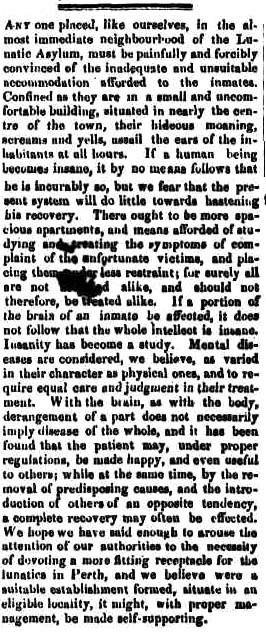This is a reconstruction of the last years of the life of Mrs Frances (Fanny) Dyson, the first wife of James Dyson, and mother to his first four children. This is a very different narrative to the one that which has heretofore been told, and has been accepted as the truth for nigh on one hundred and twenty years.
Part 1:
The Death of Fanny Dyson
This is a narrative of events. Evidence for these events are presented in Part II ![]()
At some point between early 1851 and the middle of 1852, James Dyson received into his house on the corner of Murray and King Streets, Perth, the extremely young wife of Mr Richard Edwards of Guildford. Jane Devling married Edwards during August 1850 when she was only sixteen years old (and four months pregnant with child)— so when she arrived into Dyson’s household, she also brought with her an infant daughter named Ellen Christina, who would be raised as a Dyson. By 1852, the future second Mrs Dyson was 18 years old and her new hubby about 42. James had three surviving children from his own marriage: George, aged 9; Joseph, aged 7; and William, aged 5. A daughter, Hannah, survived only a couple of months back in 1850.
But still alive and under the same roof with her husband and his new mistress was James Dyson’s first wife, Mrs Frances (Fanny) Dyson.
There did not seem to be a formal mechanism for divorce during this early period of the Swan River Colony’s history, but to give James Dyson his due, he did not just throw his wife of nine years and mother of his children out into the street when the newer and shinier model arrived. No, instead he beat her and abused her so that by the time she arrived in a state of catatonic shock before the desk of the Assistant Police Magistrate and the Colonial Surgeon, those two gentlemen felt they had no option—even though they acknowledged that she was not actually insane— but to recommend to the Governor that Mrs Dyson be committed to the Perth Lunatic Asylum. Governor Charles Fitzgerald, supreme ruler of the Colony, gave his assent to this proposal on 6 August 1852 and Mrs Dyson was sent to the converted stables on Wellington Street (next to the old race course) that served as the hospital/asylum for Perth.
Again, to Dyson’s credit: he was content to pay for his wife’s maintenance in the asylum to the value of eight shillings a week and even to (eventually) hand over her wardrobe— consisting of four gowns and two sets of undergarments. He only protested when the colonial authorities attempted to up the payment to ten shillings a week— due, they said to the extra trouble and work Mrs Dyson’s needs placed on the asylum staff. He pointed out that his work as a sawyer had been a bit “slack” lately—also, he did have three young children to feed, and the cost of living was so expensive those days… The authorities seemed to have accepted Dyson’s excuses.
Five months later, Dr Ferguson, Colonial Surgeon, responsible for Fanny’s care, wrote to the Governor to express his concern that he could do nothing further for his patient. In his opinion, Mrs Dyson was obsessed with that other woman living in her house with her husband. Ferguson made inquiries and discovered that the man that the other woman was actually married to would be all too pleased to take back his errant spouse. The Doctor’s question to the Governor: Was there anything the State could do to compel Jane Edwards to leave Dyson’s house and return to Richard Edwards?
The governor seems to have taken something of a personal interest in this case— up till now. Ferguson was instructed that he could send Mrs Dyson home with a policeman and bar her admission back into the Asylum, but after that it was solely the business of the Police Magistrate… and James Dyson. Fanny would have discovered, arriving home, Jane Edwards heavily pregnant with Fanny’s husband’s child. Just to ram home the point, when the child was born three weeks later, on 25 January 1853, the boy was christened “James” and there has never been any real doubt about who his father was.
Two months later occurred the famous street fight between Dyson and the husband of the mother of his most recent child. It would be a fair assumption that reconciliation between any of the parties was now impossible. This was the last public appearance of the luckless Mr. Richard Edwards, junior, in the records of Western Australia.
Wherever he disappeared to, everyone were so confident he was no longer alive by February 1862, James and Jane could finally have the church wedding they may well have so long planned. But if this was the case, it meant that Mrs Fanny Dyson also had to be dead as well.
***
There is no death certificate for Mrs Fanny Dyson. Her gravestone in East Perth Cemetery has a patently wrong year on it of 1850, but it was erected it nearly fifty years after her alleged death, and by someone not born when she died.
Fanny most likely died some time before June 1854. 12 May 1854 is the best guess at an exact date.
Fanny was most likely back in the Perth Lunatic Asylum. She certainly was not being looked after by Jane and James. Five months previously, Governor Fitzgerald who confirmed her original commitment to the asylum, presented a school prize to her son for academic achievement. It was unlikely she was allowed to attend the ceremony. Jane and James were also expecting their second child together (assuming Ellen Christina was not also James’s daughter) before Fanny finally was no more.
It was 1861 before a purpose-built building began construction in Fremantle to finally replace the Perth Lunatic Asylum. Records concerning mental health don’t even begin to be preserved in this colony until the opening of the Fremantle facility so the exact circumstances of Fanny’s death have not been preserved. Another possible explanation for this silence might just be embarrassment, or shame. Shame over the stigma of mental illness and official embarrassment that her end had occurred while she had been in the government’s care. The only formal record that the first Mrs Dyson had passed comes in the form of a rare surviving Police charge sheet from 1854, describing how James Dyson was called before the police magistrate yet again, this time charged with refusing to support his wife. The local newspapers, which published most court proceeding, also chose not to report this event. The charge was dismissed because by 25 May 1854 James Dyson had no lawfully-recognised wife to support.
Fanny Dyson had taken her own life.
The inconvenient truth of her existence could now be comfortably ignored.
the Evidence







Kerri
Although I am descended from James and Jane I have so much empathy for Frances Hoffingham. Her fate is immensely sad and tragic. I guess the very least James could have done for her was to perhaps even rent her a house to live in or find her some respectable accommodation.
Alan Thompson
I’m not sure there were any other safe places she could go. There were a mass of free immigrants in town at the time as well all the new convicts and pensioner guards. I am in no way excusing or justifying James’s treatment of his wife.